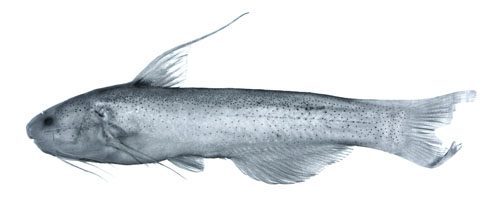Whale Catfishes
The family Cetopsidae consists of 41 known species of small to moderate sized fishes which share an anal fin with a long base, a lack of spines in the pectoral and dorsal fins other than in a few species of the subfamily Cetopsinae, and the lack of a nasal barbel, a free orbital margin and bony plates on the body. The two subfamilies of the Cetopsidae, the Cetopsinae and Helogeninae have been traditionally recognized at the family level, but were subsequently shown to be each other’s sister group and brought together in an expanded Cetopsidae.

The members of the subfamily Cetopsinae have smooth bodies lacking body plates or an adipose fin and reduced or absent dorsal and pelvic-fin species and eyes. In trans-Andean South America cetopsines are found along the Pacific slope from the Jurubida River of Colombia south to the Tumbes River of northern Peru. Along the Caribbean trans-Andean versant species of cetopsines occur from the Sinu River of northwestern Colombia east to the Lago Maracaibo basin of northwestern Venezuela. East of the Andean Cordilleras, the Cetopsinae occurs in the Aroa and Yaracuy River basins along the Caribbean versant of northern Venezuela, through the Orinoco River system and the coastal rivers of the Guianas, south through the Amazon basin to the southern portions of the La Plata River basin. Cetopsines also occur in the Juquia River basin of the state of Sao Paulo and the Sao Francisco River basin of eastern Brazil.
The species of the Helogeninae have smooth bodies which lack body plates, with the adipose fin usually present, but reduced or absent in some populations of one species, the dorsal and pectoral fins lack spines and an elongate base on the anal fin. The species of the single contained genus, Helogenes, occur through much of the Amazon basin, the southern portions of the Orinoco River basin, the coastal rivers of the Guianas, and at least the lower portions of the Tocantins River.
The larger cetopsine species of the genus Cetopsis are notorious for their feeding habits; attacking not only carrion, but also live fishes in gill-nets and on occasion humans Some members of the subfamily have been erroneously thought to be parasitic. Most species in the Cetopsinae feed on allochthonus terrestrial insects, a food habit also shared with Helogenes species.
Information from: VARI, R. P., and C. J. FERRARIS, JR. 2003. Cetopsidae, p. 257-260. In: Check list of the Freshwater Fishes of South and Central America. R. E. Reis, S. O. Kullander, and C. J. Ferraris, Jr. (eds.), Edipucrs, Porto Alegre, Brazil.
Cetopsids are organized into 5 genera:
- Cetopsidium, 6 species.
- Cetopsis, 21 species.
- Denticetopsis, 7 species.
- Helogenes, 4 species.
- Paracetopsis, 3 species.